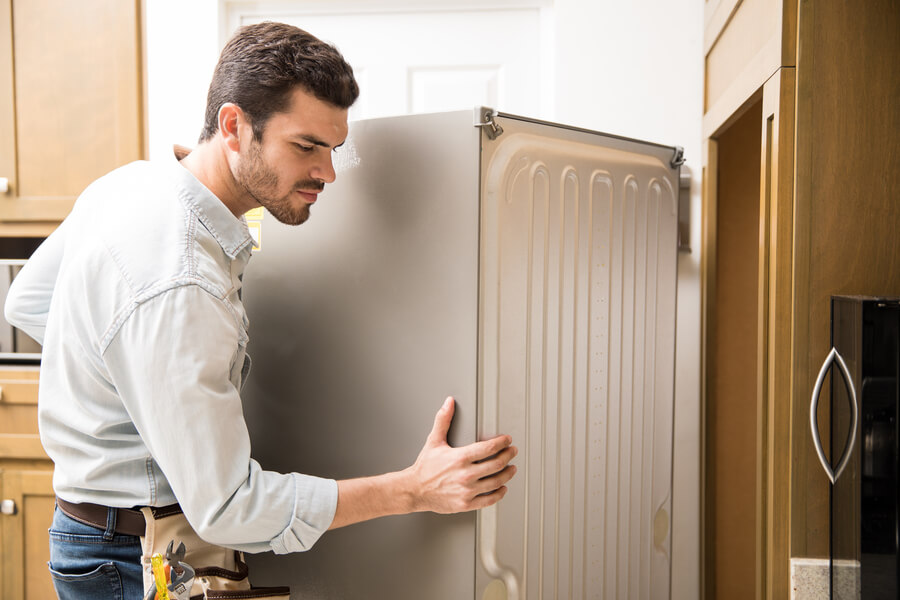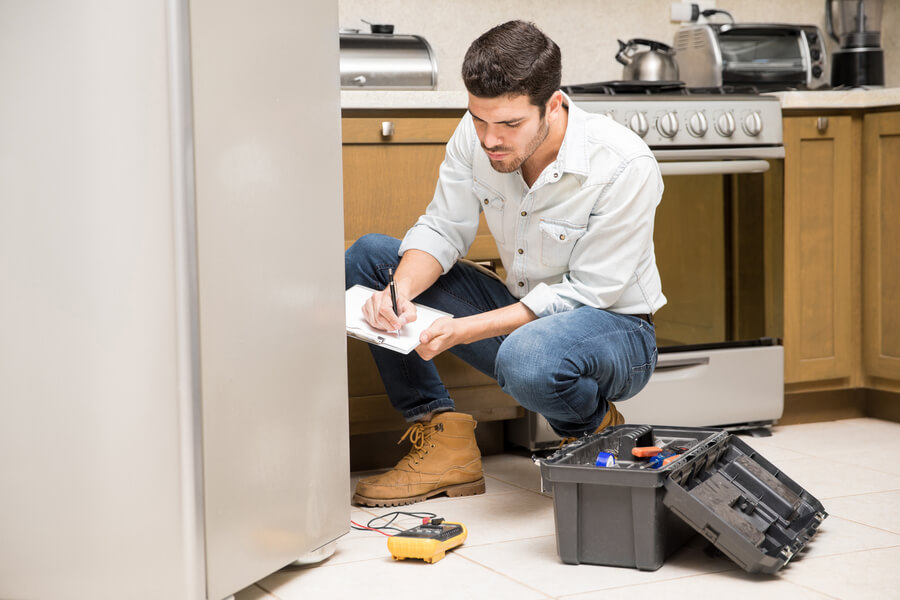This article will discuss a common problem with LG refrigerators: when the evaporator fan isn’t running correctly. We’ll explain what could be causing this issue and provide solutions to help you get your fridge up and running again.

LG Refrigerator Evaporator Fan Not Running: Causes and Solutions
The fan inside the refrigerator helps make things cold. It blows air over the coils that make the cold, which goes around the fridge and freezer. Some fridges have more than one of these fans. If there’s only one, it’s in the freezer.
If this fan doesn’t work, the fridge won’t get cold, and you’ll have a problem with your LG fridge. The freezer might still be cold, but not the fridge (one of the common issues with LG fridges).
The following guide can help you determine if the evaporator fan isn’t working and solve the issue if it’s solvable.
First, Test the Evaporator Fan One Last Time
First, let’s check if the evaporator fan is broken. Here’s how:
Check for Light
Open your freezer door and see any light inside. If your freezer has a light bulb, it should turn on when you open the door.If it doesn’t, it might not get power, so check if it’s plugged in correctly and inspect the breaker or fuse for that part of your home.
Feel for Cold Air
If the freezer’s evaporator fan motor isn’t working, your freezer might start to thaw. Open the freezer door and feel inside with your hand.
If it’s not cold, there might be an issue. Usually, the evaporator fan doesn’t run when the door is open, so if it’s working, it will stop when you open the door. Also, make sure your freezer is set to a cold temperature.
Locate the Door Switch
Your freezer has a switch that gets pressed when you close the door. This switch controls the light and the evaporator fan motor.
Look around the door frame of the freezer to find this switch. It’s often the same color as the inside of the freezer and is usually placed low on the door frame.
Press and Hold the Switch
Hold the switch for about a minute. The freezer light should turn off, and the evaporator fan should start running after a few seconds.
You should hear the electric motor starting and a low hum from the fan spinning. If the fan doesn’t start while you hold the switch, it’s probably a faulty motor.
But if you can hear the fan running and the freezer isn’t cold, the issue might not be with the evaporator fan motor.
Listen for Strange Noises
If the evaporator fan motor goes wrong, it may make a high-pitched sound that comes and goes.
If you hear this sound, something could be stuck in the fan blades, or the motor might fail. To investigate, you’ll need to remove the rear panel to access the fan motor.
The condenser usually isn’t located at the back of the freezer, so the noise should come from the evaporator fan motor.
Then, Access the Evaporator Fan
Here’s how to access the evaporator fan:
Unplug the Refrigerator
The evaporator fan motor is electronic, so you must ensure no electricity flows before doing any work.
To unplug the freezer, move it away from the wall to reach the outlet behind it. If you can’t get to the outlet, turn off the power for that room using the breaker or fuse box in your house.
Not unplugging it could lead to severe shocks or burns.

Clear the Freezer
Removing the rear panel screws will likely come out as one piece.
To do this, you’ll need to take everything out of the freezer, including shelves. Removing the shelves gives you more space to work.
If any hardware comes out with the shelves, keep it safe to use when you put the shelves back.
Remove Air Ducts
The evaporator fan motor is behind the rear panel of the freezer, but first, you must unscrew and remove any air ducts attached to the back of the freezer.
Place the vents and mounting hardware in a safe spot.
Typically, a Phillips head screwdriver will help you remove the ducts.
Take Out Panel Screws
You should see screws securing the rear panel with the ducts out of the way. Use a screwdriver to remove each screw and keep them in a safe place.
Most freezers use Phillips head screws, but some may require a socket wrench. Usually, at least four screws hold the panel in place, but the number and location vary in different freezers.
Disconnect the Fan Motor Wiring
If the fan motor is attached to the panel rather than the back of the freezer, lay the board down inside the freezer to access the wiring connected to the fan.
If not, you can disconnect the wiring after removing the rear panel. There should be some slack in the wire to make it accessible.
Slide Out the Rear Panel
The entire rear panel should come out as one piece, although it might seem a bit stuck initially.
If it doesn’t come off quickly, check if you missed any screws still holding it in place. Handle the panel gently as you slide it out to avoid bending it.
Keep the panel safe until you’re ready to reassemble the freezer.
Finally, Try to Fix the Evaporator Fan
Here’s how to identify the issue and possibly fix the evaporator fan:
Check for Frost on Coils
If you remove the freezer’s back panel and see the coils beneath the fan covered in frost, the fan motor might be okay, and the issue could be something else.
If you find frost on all the coils, unplug the refrigerator for 24-48 hours to let it thaw, then plug it back in.
The problem isn’t with the fan motor if the freezer works properly after thawing. Other potential issues could be a stuck condenser fan or a faulty relay, which may require a certified technician to fix.
Clear Fan Blades
Sometimes, things can get stuck in the fan blades and stop the motor. Check for any strings or plastic caught in the edges.
Remove something and turn the freezer’s power back on if you find something stuck.
Hold down the freezer door switch and check if the fan starts spinning. You’ll likely need to replace the fan motor if it doesn’t.
Locate Fan Motor Wires
Look for the wires leading into the fan motor. Three wires should go to the evaporator fan motor: two together and one separate (the ground).
These wires might be part of the same plug harness. Wire colors can vary between freezer models.

Test Motor with a Multimeter
Plug the multimeter probes into the two wires connected to the evaporator motor. Then, please turn on the multimeter and set it to measure resistance (Ohms).
Note the reading on the multimeter and compare it to the specified resistance for the evaporator motor.You can find the correct resistance values in the owner’s manual, a specific repair manual, or the manufacturer’s website.
If the reading doesn’t match the manufacturer’s specifications, the evaporator motor must be replaced.
Conclusion
When your LG refrigerator’s evaporator fan isn’t running, it can lead to cooling issues.
But don’t worry; you can troubleshoot and fix the issue yourself.
By checking for frost, clearing fan blades, and testing the fan motor, you can return your fridge to keep your food cold and fresh.
If you’re unsure or need further help, consult a technician to ensure your refrigerator runs smoothly.
